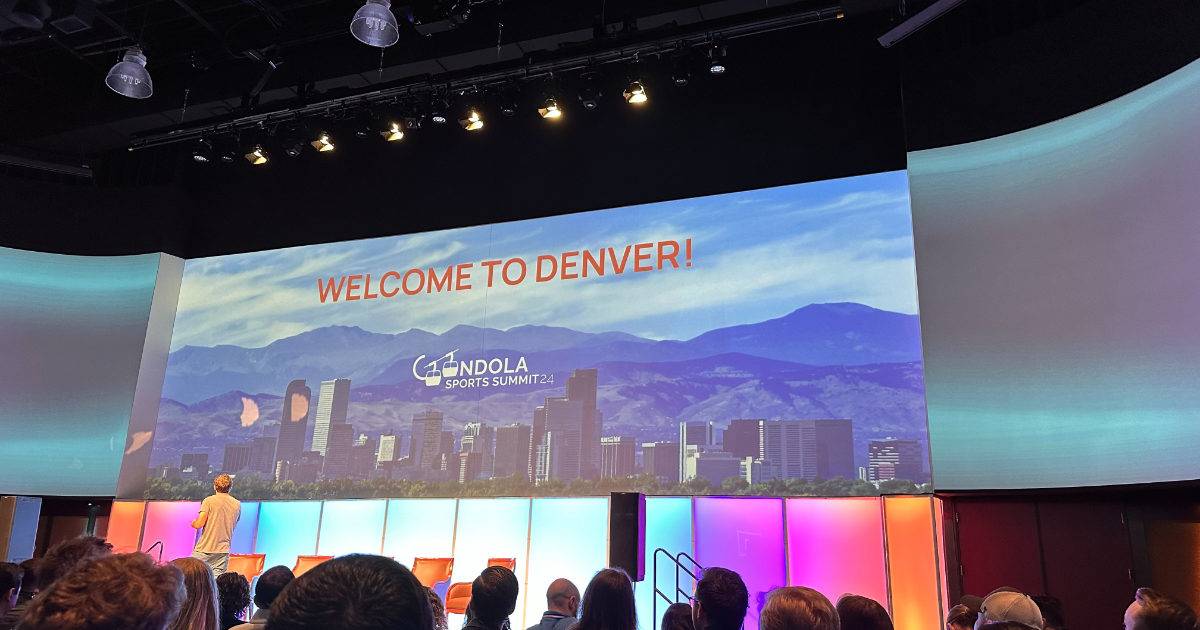Anyone can post on social media. Pretty much everybody you know has posted on Instagram or Facebook at some point in their lives, if not daily. But just like not everyone who drives a car knows what’s going on under the hood, your average social media user has little understanding of the immense sports content operation behind your favorite team’s feeds.
The recent Gondola Sports Summit brought together experts in the greater sports space who know every nook and cranny of the sports content engine.
Fans enjoy the content produced and posted by their favorite leagues, teams, athletes and media. However, it takes talented and sharp pros like those at this event to architect and execute thoughtful, complex content operations and programs. And they need to do it with such fluency that it at least looks easy to your average Instagrammer.
Knowledge flowed and the energy and creativity were palpable across a day and a half in Denver. At Greenfly, we’re delighted to share a few insights imparted by some of the leaders in the space who bring all this content to life and make the massive sports industry drive like a well-oiled machine.
You Can’t Be the Best at Sports Content Without Also Being the Best at Efficiency
The title above was inspired by a statement from Matt Boyer, Director of Digital and Social Media for the Colorado Rapids, who was part of a panel about content workflows in sports. There was a lot of in-the-weeds discussion of organization, execution and why systems and operations matter even in a field where creativity shines. You need to know what makes great content. But you also need to know the processes that make great content work.
Discussing content workflows, shot sheets and metadata requirements isn’t as sexy as devising memes or crafting the perfect caption (both of which do matter). However, multiple panels demonstrated why organization and operation are prerequisites and invaluable.
Communicate Your Processes Across Your Organization
We’re all storytellers at heart. So, putting the processes into perspective with a good story can make conversations about topics like tags and metadata come to life across the organization. The Rapids’ Boyer noted how helpful it is to ensure each department understands the systems and processes in place and why they matter. This provides visibility and #TheMoreYouKnow value and also helps uncover efficiencies and opportunities.
Content is important to every department of a sports organization. Achieving alignment can open up opportunities to collaborate, find synergies, and even combine forces (and budgets) to uncover solutions.
Does your partnerships team know about your content workflow? Does the marketing team know the right tags to search for specific content needs? And does your social media and creative team have the minute-by-minute run-of-show for the game presentation? The best content and outcomes start from the best processes and preparation.
Treat Athletes Like Humans
Players are the main characters in the majority of stories we tell. They are who fans form connections with, and why they invest their time, hearts and money. So much of content success starts with optimizing how we work with and around the athletes. It’s not exactly breaking news, but there were a lot of lessons to learn about how content teams can get the most out of their stories’ main characters.
On a panel focused on working with athletes, one of the speakers had a memorable plea when they said that creatives should put down the camera to connect with athletes as humans.
The media day panel noted the importance of spending as much time on athlete research preparation as you do on sets and camera setups. Athletes can tell when you’ve done the homework. Personalization shows you care about them as individuals. And that results in better content and a better experience and relationship overall.
Many player marketing teams these days have something of a CRM for their athletes. So, they have an idea of the interests, affinities and values, among other informational inputs, to know what content and opportunities to present to players.
Building relationships with athletes also means they’re more than just cogs for a sports content piece and stars of the team’s show (and social channels) for the season or tournament.
Devin Dismang works with athletes for the X Games and noted that while the X Games may be only a few days each year, the growth of the platforms and profiles of these athletes benefits the X Games 24/7/365. It’s about more than just how the organization and the athlete can help each other today. It’s also about setting them up for success well beyond when they step off the podium or when the content feature shoot is finished.
It was also a treat to hear from Denver Broncos player Patrick Surtain II on the Working with Athletes panel. Surtain is an Elite (capital E) player. So, everybody leaned in when an audience member asked him what he would want from the team’s content producers and social staff.
He noted that he recognizes they’re the experts in what they do and would welcome tips about how to use his channels and post content, whether it’s his content or content provided to him by the team. He would later talk about goal setting. These athletes thrive on setting and accomplishing goals, which can apply to the brand building they do through social media posts and content they create or co-create, too.
Many attendees and speakers at the Summit have long since become desensitized to working alongside superstar athletes — opportunities that would make everyday fans swoon. The best teams form relationships with players. They recognize the mutual benefits gained from collaboration and the trust that is earned when you can show the players you’ve put in the work and you care about their success.
Make Influencer and Creator Activations Easy and Mutually Beneficial
The influencer and creator space has been part of social media and content marketing (including in sports) for years. However, its importance has rapidly risen within the sports industry in the last few years. Leagues, even teams, have dedicated positions and staff focused on connecting with influencers or creators (there is a difference) and activating those relationships. That’s why a panel was dedicated to it at the Sports Summit!
While the experts noted there is value in the relatively transactional influencer relationships — tickets to a game, for example — the more collaborative content campaigns, events, and activations were the primary topic of discussion. Once the right partner is identified (that’s a separate article), it’s important to recognize there’s a two-way relationship at play. Both sides should benefit.
So, a pragmatic piece of advice was to ask the influencer what they want out of the experience — and come to them with the benefits and opportunities your organization can provide.
Each side should be excited about the opportunity, which makes for more authentic content that resonates with all fans. The NHL’s Neil Tennant noted that they look for creators and influencers who have a genuine connection to the sport, an essential qualifying element for any potential collaborator.
It’s also about making it easy. Brendan Kaminsky, who has years of experience working with creators and influencers in sports and runs the bknown agency, advised that relatively easy content opportunities tend to win. If you’re hosting an influencer or creator at a game or event, how can you facilitate their content creation and social posting efforts? When they’re not stressing about capturing the content they want or need, it’s a better experience. And it’s more likely they’ll fill up their feeds with content showcasing your team, league, or event.
Realize All the Value of Your Sports Content
“A good piece of content can break down silos across an organization.”
This statement from Sponcon Sports’ Alex Kopilow encapsulates so much of the strategic discussion at the Gondola Sports Summit.
Whether it was the content strategy discussions, the chats about operations and workflows, the panel discussing live content correspondent programs, or Kopilow’s portion about sponsored and branded content — we’ve only just begun maximizing the value of all the content collected and produced within sports.
The content correspondents panel illustrated the breadth and depth inherent to content programs now. On a given game day, thousands of original photos and videos are produced. And that’s not even including the typical sports highlights shown on the evening news. The panelists spoke about focusing on getting the content to every party that could make valuable use of it — and figuring out how to do it as efficiently as possible.
There is also an educational component at play, too. This is where communication and collaboration are key.
Content teams gain an understanding of the goals and challenges of each department (and vice versa) to convey and realize the value of content and ask what each stakeholder wants and needs. Even if they’re not using the content every day, it was noted that just the visibility into the content program can unlock value — tangible and intangible.
One example discussed in Kopilow’s panel, and, coincidentally, also showcased by Snap the next day, was the value of capturing the planned or unplanned in-game elements. These include video board gimmicks or on-field contests. When they get into the hands of the social team, they can pop off in the feeds, turning an audience of thousands into millions. And they add massive value for sponsors, when applicable.
Snap showed examples of their AR technology being used on videoboards, noting an example of it going viral on social media when the Indiana Pacers made it appear visiting Lakers fans were crying, thanks to the Snap lens (via Camera Kit).
At Greenfly, we’ve seen tremendous new value created when short-form LCC content gets into the hands of broadcasters globally. Or the value created when the sponsorship team of a league was made aware of the massive reach of real-time game day content from the sideline, then packaged and sold significant new deals.
Final Thoughts
Sports teams and leagues have gotten really good at monetizing their live games, with media rights deals accruing billions annually. But we’re still in the first half, if not the first inning, of monetizing all the other content (reaching more fans) that content social and digital pros have spent the past several years mastering.
The group of professionals at the Gondola Sports Summit has shaped how fans consume and engage with sports. They’ll also play a major role in constructing and engineering the sports’ business models in the future, too. If the days spent at the Summit are any indication, the industry is in good hands.
For more insights on short-form content in sports, reach out to us.
Photo credit: Marty Summa

